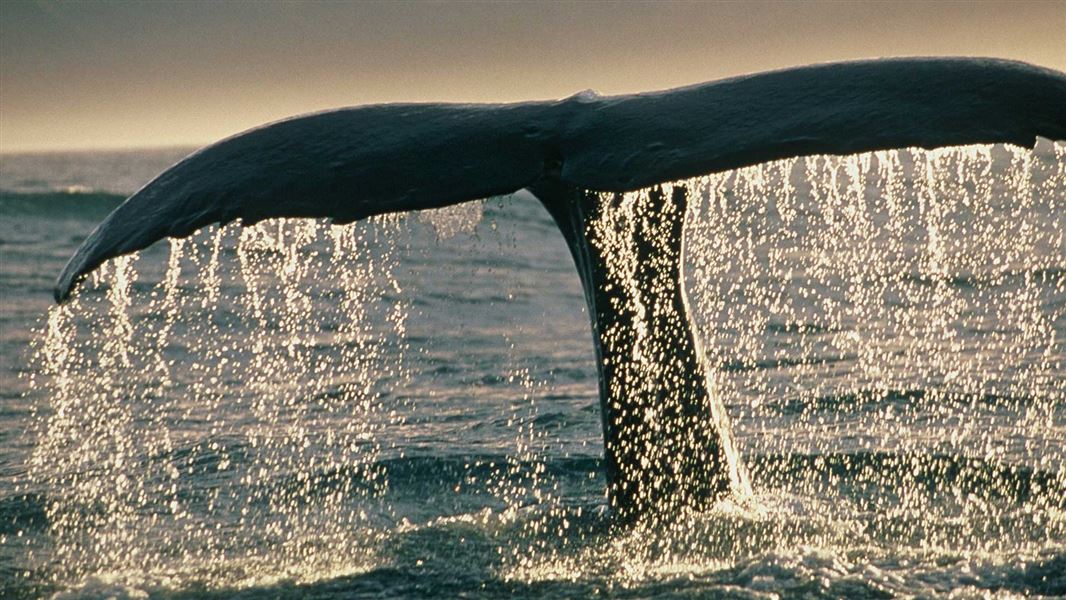Facts
Sperm whales (Physeter macrocephalus) have wrinkly skin and a large rather square head that makes up around one third of their body length. Females are smaller than males and have a proportionately smaller head.
They are purplish-brown or dark grey in colour, with white underneath. The dorsal fin has been reduced to a low hump and there is only one, slit-like blowhole, situated on the top left side of the snout.
Their angled, bushy blows make them easy to spot even though they rarely show much more above the surface.
- Newborn: length 3.5-4.5 m
- Adult: length 11-18 m
Range
These animals are widespread around the world, but have a patchy distribution. They prefer deep water (>200m) and so are usually found offshore and in areas with submarine canyons, such as Kaikoura, where sperm whales are present all year round.
They generally move towards the poles in summer, males more so than females and juveniles. Females usually inhabit water deeper than 1000 m at latitudes less than 40-50°. Male distribution extends to more temperate latitudes.
Population
Kaikoura is home to the most well studied New Zealand population of sperm whales; it includes both resident and transient individuals, mostly males. It appears that there is no other area in the world where this species is routinely found so close to the coast (Dawson et al., 1996).
In November 2016, a 7.8 magnitude earthquake triggered a ‘canyon flushing’ event in the submarine canyon of Kaikoura. Underwater landslips and turbidity currents caused significant changes to the seafloor and removed large quantities of benthic biomass from the canyon. The impact of the earthquake on habitat use by sperm whales was examined to look at changes in their behaviour, foraging distribution and use of food resources before and after the earthquake. Observations suggested that the earthquake caused alterations in the foraging patterns of sperm whales over a period of at least 12 months. Read more in the paper by Guerra et al, 2020 (PDF, 1,439K).
Diet and foraging
Sperm whales are toothed whales and dive to great depths to feed. They eat large organisms, mainly squids, but males are also likely to eat demersal fish including sharks and rays. They feed using clicks, which can both locate and possibly stun their prey. Dives have been known to last for over one hour and can be deeper than 1000 m. Most dives tend to last around 35 minutes however, extending down to 400 m.
Life history
Females reach sexual maturity at around 9 years old and give birth roughly once every 5 years to one calf. Gestation lasts for approximately 14-16 months. Males appear to not reach full sexual maturity until their late twenties. Sperm whales are long lived and do not reach physical maturity until about 30 years old (females) and 50 years old (males).
Threats

Sperm whale being cut up at whaling station, 1975. Sperm whales were one of the most heavily exploited of all the world’s whales
Killer whales have been seen attacking sperm whales, but usually unsuccessfully. Pilot whales are also known to harass them. Other potential predators of younger animals include large sharks. When confronted with predators individuals are known to cluster together into defensive formations.
Human impact
These whales were one of the most heavily exploited of all the world’s whales, although they are still relatively abundant. Present day threats include entanglement in fishing gear and collision with ships.
Studies on the effects of tourism on sperm whales have found them to react negatively to rapid approaches by vessels, sudden changes in speed and close approaches (MacGibbon, 1991). Whales respond by spending less time at the surface, and so tourism has an impact on their normal behaviour.
DOC's work
DOC undertakes management and monitoring of Kaikoura whale-watching operations in an attempt to mitigate the effects of tourism on this species.
DOC is also responsible for managing stranding events.
Report sightings
You can report sightings of whales to our conservation hotline 0800 DOCHOT (0800 362 468). You can also report a sighting online.
Reports of sightings are always valuable and help increase our knowledge of whale distribution and movements around New Zealand.
If you need help identifying species, download the marine mammal sighting form (PDF, 416K) (Word, 4,300K). You can use the images and descriptions to find out which species of whale you observed.
Record the details
Include as much information as possible with your sighting:
- the date, time and location (GPS coordinates if possible)
- the number of whales and whether any are calves
- the direction they were travelling
- take photographs or video; focus on identifying marks, the left side of the head, and shots of the full length of the body.
How to approach whales (including orca and pilot whales)
From a boat:
- carefully approach whales from the side and slightly to the rear, keeping a distance of at least 50 m at all times
- operate your boat slowly and quietly at ‘no wake’ speed within 300 m
- don't approach a whale if three or more boats are already within 300 m of the animal
- if a whale moves towards your boat, try and manoeuvre out of its path and keep 50 m away; if this is not possible, slow down and stop
- manoeuvre your boat carefully and cooperate with other boats in the area
- don't obstruct the whale’s path, cut through a group or separate mothers from calves
- avoid loud or sudden noises that could startle whales
- don't enter the water; swimming with whales is not permitted. .
You can also help keep their environment clean by taking rubbish home with you or disposing of it appropriately on land. Some rubbish can be lethal to whales.
It is an offence under the Marine Mammals Protection Act 1978 (MMPA) to disturb, harass, harm, injure or kill a whale. Anyone charged under the MMPA with harassing, disturbing, injuring or killing a whale faces a maximum penalty of two years’ imprisonment or a fine to a maximum of $250,000.
If you accidentally catch or harm a whale
If you accidentally catch or harm a whale, including ship strike, you must report it as soon as possible to our conservation hotline 0800 DOCHOT (0800 362 468) or the Ministry for Primary Industries (0800 008 333).
Never attempt to release a whale entangled in a net or rope. Entangled whales are very dangerous and disentanglement should only be undertaken by specially trained personnel. In these circumstance, contact our hotline immediately.
